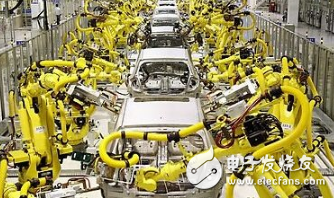China's industrial robots produced more than 70,000 units from January to July this year, a year-on-year increase of more than 50%. The industry predicts that China's industrial robot sales will reach 110,000 units in 2017, and will exceed 200,000 units by 2020, nearly two times more than in 2015. By 2020, the number of industrial robots will reach 1 million units.
"Made in China 2025" clearly regards robots as a key breakthrough area, and the robot industry is developing rapidly, especially industrial robots have become the world's largest market. However, due to factors such as technology and brand, the Chinese robot industry is currently in the tough stage.

With the gradual disappearance of the demographic dividend, China has become the world's largest industrial robot market. According to the Ministry of Industry and Information Technology, by 2020, China will form a relatively complete industrial robot industry system, with a high-end market share of more than 45%.
Industrial robots are one of the important basic equipment for implementing automated production lines, industrial 4.0, intelligent manufacturing workshops, digital factories, and smart factories. The industrial robot industry is the backbone of the continued development of the Chinese manufacturing industry.
According to the World Health Organization, by 2050, China will have 35% of its population over 60 years old, making it the world's most aging country. However, the penetration rate of domestic robots is extremely low. In 2013, the number of robots per 10,000 labor force in China was only 23, which was significantly lower than that of the United States (146), Japan (332), and South Korea (396).
China wants to implement "Made in China 2025". Intelligent manufacturing is the main direction. China has a good R&D foundation in the key basic technology fields of intelligent manufacturing, but it still has a long way to go to fully develop the goal of intelligent manufacturing.
At the government level, "Made in China 2025" clearly defines robots as a key development area, encourages the development of new robot products, breaks through bottlenecks such as key components and system integration design and manufacturing, and contributes to the development of intelligent manufacturing.
In order to implement the "Made in China 2025" as the overall deployment of the key development areas and promote the rapid, healthy and sustainable development of China's robot industry, "Robot Industry Development Plan (2016-2020)" proposes: By 2020, China's own brand The annual output of industrial robots reaches 100,000 units, and the annual output of industrial robots with six axes and above reaches 50,000 units.
However, the development of China's industrial robots is not a smooth road on China's 2025, mainly subject to two major factors. On the one hand, the global industrial robot market has long been monopolized by international giants. The four major families account for half of the global industrial robot market share, and the Chinese market accounts for an astonishing 70%. Compared with the international robot giants, Chinese companies are at a disadvantage in the competition of brands, technologies, production capacity and cost.
On the other hand, although industrial robots are in line with the development of the times and the industry has broad prospects, the contradiction between the imbalance of supply and demand of talents in this field is increasingly prominent. On the one hand, robot manufacturers, system integrators, and automobile processing industries are eager for talents. On the other hand, talent supply is insufficient, and it is difficult to meet the needs of enterprises.
The reason is mainly due to the explosive development trend of the domestic robot industry in recent years. The curriculum of training institutions such as universities and vocational schools still lags behind. Although some robot manufacturers provide relevant training, there are too many brands targeted. Shortcomings such as insufficient promotion, inadequate supporting facilities and limited training outlets make it difficult to achieve a systematic teaching process, which is still not well suited to the needs of scholars across the country, resulting in many people who are interested in the robotics industry.
In the next few years, with the rapid development of China's manufacturing industry, especially the automobile and auto parts manufacturing industry and the motorcycle industry, the assembly volume of industrial robots will increase steadily. At present, the main application fields of domestic industrial robots are automobile, electronic and electrical, rubber and plastics, metallurgy, food, medicine and cosmetics. As technology advances, the field of application of industrial robots will also expand rapidly.
Big Stage,juegos de sala,maquina de juegos,Tragamonedas
Guangzhou Ruihong Electronic Technology CO.,Ltd , https://www.callegame.com